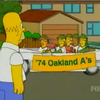Ted Lilly will start on Tuesday. Sort of. Lilly will be the guy on the bump in the first inning, but we don't equate a starter with a guy who isn't going to go the distance. Lilly will be on a pitch count of 50-60 pitches which equates to about three or four innings with all the other playoff implications flying around. Lilly hasn't pitched since mid-July. Throwing him out against Anaheim has good points and bad points.
GOOD:
First, he's pitching his biggest game of the year and possibly of his big league career.
Second, it's with new, improved/altered mechanics forcing Lilly to concentrate on his actions and center his focus.
Third, even moderate effectiveness will result in a superlative result in Lilly's progress.
BAD:
See GOOD, first through third.
Aaron Harang will be ready by the third inning to take over and the bullpen should be well rested.
For those who have never thrown anything overhand and have heard snickerings and references to a "girl's arm" there are a few things you need to know about the mechanics of throwing.
When you throw something overhand, in reality you are throwing you arm away from your body. As many times as you watch a pitcher come to the plate, it is still amazing that an arm or two doesn't come flying off toward the third base side.
In Lilly's case, A's Pitching Coach Rick Peterson made efforts to simplify the problem(s) with Lilly's mechanics. He related the main problem to the brake pads (think of those bumpy triangle things in the mid-upper part of your back). It's a polite way of saying that Lilly pitches with all arm and doesn't let his lower body do the work. He pitches inefficiently and it is harder to make adjustments with his arm, arm angle and release when that much stress is place on 1/8th of the body.
If you need a reference to good mechanics, watch Mark Mulder from the Left side and Greg Maddux from the right side. Maddux happens to be an athlete who plays pitcher.
Ever wonder why some pitchers are called good athletes and why some couldn't throw the ball overhand to first base to save their life?
Asking a pitcher to throw over to first base is sometimes watching a subject walk out of a Skinner box. Sometimes you just fully accept that fact that a pitcher may have a nervous breakdown throwing the ball anywhere but at the catcher behind home plate.
It's the same thing they call, "touch" in football to describe a Quarterbacks ability to throw a football. Some big arm QB's can't throw a simple swing pass to a back out of the backfield, but they can throw a bullet 60 yards downfield on a line. Some can loft a ball on a fade route that can evade two defenders and wind up hitting the receiver over the outside shoulder in stride 40 yards downfield but can't throw the ball more than 50 yards without coming out of their shoes.
By the way, guess who gets recruited, drafted and big contract? The big arm QB.
It's about arm angles and kinesthetics, the mechanics of body movement.
It takes more than a big arm to be a good QB and it takes more than a mid 90's fastball to be a good pitcher.
Most pitchers have to whip their hips around, face a target and throw in an exaggerated motion to get a simple toss to first.
That's why you'll sometimes see a pitcher just tossing the ball underhand. They can't gauge arm speed, trunk speed and lower body speed fast enough to realize where the ball is headed.
The major difference is watching Maddux field his position. When he has to make a difficult throw to first, you don't see an elaborate movement or underhand toss. Maddux can throw at any arm angle because his lower, middle and upper body are all in the same motion at accommodating speeds. His motion is efficient and nearly flawless on a pickoff thorw to second, fielding a sacrifice bunt or on a 2-2 change-up.


Add a Reply